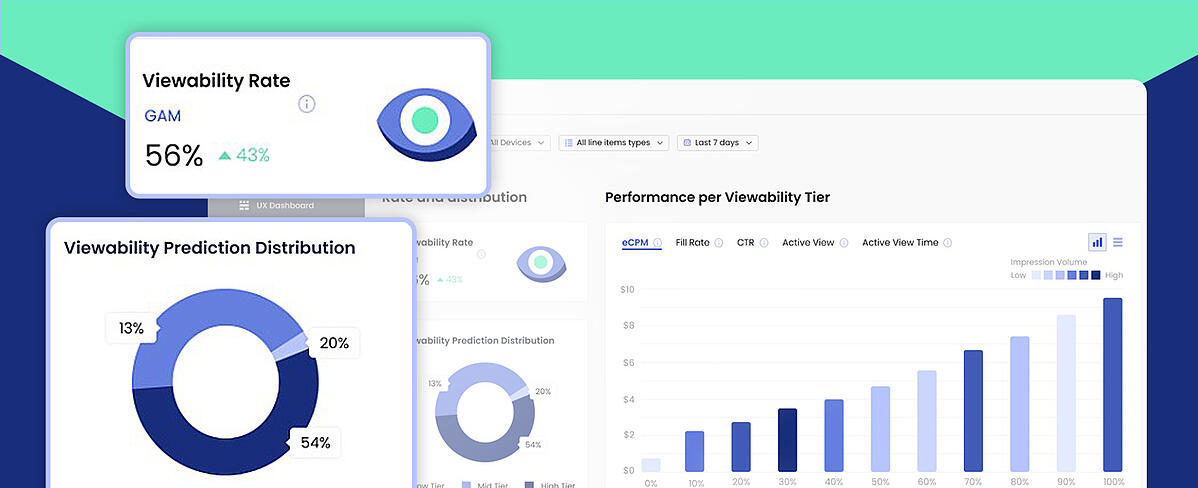Viewability and ad scale – how to achieve a perfect equilibrium?
By Asaf Shamly | January 28, 2021

Mobile Web usage is booming, which is great, but its prosperity has also opened a Pandora’s Box of challenges for Mobile Web publishers. New and old problems continue to surface, such as different screen sizes, load speed, limited ad’s sizes, number of ads that can be presented per page, and erratic user behavior that results in unstable engagement with website content and ads. All these issues have a direct and immediate impact on ad viewability, affecting the publisher’s revenue, internal cost, and brand.

Let’s start at the beginning and refresh our memories on what ad viewability actually means. Thispage does a great job in giving the whole viewability spiel, and here’s a snapshot of what they say: The IAB (along with the MRC) have defined Ad viewability as the online advertising metric that keeps track of impressions that were actually viewed by users. This metric is defined by two parts – what percentage of ad was viewable and for how long? An ad is deemed viewable when 50% of the unit (measured in pixels) is in the user’s viewport for at least a second.
Advertisers consider the lack of viewable ads as one of the biggest hurdles in the digital ad supply chain and are refusing to continue paying for that. A great example of this trend is Group M and you can read all about their journey towards viewability here.
This changing landscape makes it absolutely critical for Mobile Web publishers to constantly optimize their ad placements, looking for that scale-viewability-user experience-supply equilibrium to generate the best possible bottom line. There are three possible approaches to go about achieving this equilibrium – let’s look at their pros and cons:
Approach #1: Fixed placements
In order to accurately forecast inventory, many publishers fixate their placements per site, section and at times per article layout. This makes forecasting real easy and convenient with a fast and easy setup and maintenance. However, there is a good chance the publisher is missing out on important viewable ad opportunities, and ending up with a large portion of non-viewable inventory – which is problematic, to say the least, in today’s evolving online advertising landscape.
Approach #2: Injected placements
Injection logic is usually a custom-made internal technology, designed to automatically insert ads, using some predefined business rules such as fixed paragraphs, text length, number of folds and more. This approach ensures each page gets the maximal number of ads per its compliance with the predefined composition (yet without really solving the viewability issue). It’s also usually done internally which gives publishers a better sense and control of their ad inventory .The flip side is that publishers rarely possess the resources to function as tech companies; building out a system internally requires strong, available and agile development teams, which is not always the case at media outlets.
Approach #3: Dynamic placements
Ad placements are a vital part of any article. Their performance is not only impacted by “dry” factors like the content itself, page structure, traffic sources, device size and more, but also by behavioural factors like scrolling patterns and depth, level of interest, time of day and day of week and more. In many cases, fixed or injected placements do not take into account these factors, applying instead a one-size-fits-all approach.
No matter what supply strategy you’d use, it’s virtually impossible to meet advertisers’ KPIs (performance, viewability), to create a positive monetization experience (ad density, acceptable locations/formats) while increasing revenue at the same time. Something needs to give and many Product, Revenue and BI teams make that tough decision when they plan their ad layout.
Dynamic placements are the future of supply creation. Tackling this requires a fully dedicated team of developers, BI and Product people to analyse each article, to analyse how the current ad layout is impacted from what’s happening on the page, and to rapidly react (ideally within 24-48 hours) by moving things around for better viewability, scale and hopefully happy users. Whether trying to build tech to do part of the job, or simply doing everything manually, this is an expensive in-house proposition.
Summary
Creating better, viewable ad-supply is becoming more and more critical as it will have a growing effect on the publisher’s bottom line. However, moving that direction can prove to be expensive, arduous and resource heavy as it requires a strong Product & BI team, agile development resources as well as constant maintenance and attention. This pushes ROI on the effort further and further away. This situation presents a strong case for data-driven automation, which we believe will lead more publishers to consider tools that streamline the journey to more user-driven, scalable and viewable ad-supply while keeping investment levels at bay and making positive ROI feasible.
Latest Articles
-

Do NOT make me choose between a great UX and boosting my revenue!!
The ongoing clashes between revenue, product, and editorial teams are painful to say the least. It doesn’t have to be this way.
View Now -

Your Brand New Viewability Dashboard!
Understand your inventory breakdown with the new Viewability Dashboard.
View Now -

Maximize Your UX & Revenue Data With Personalized Reports
Ready to uncover insights and step up your ad layout strategy?
View Now
